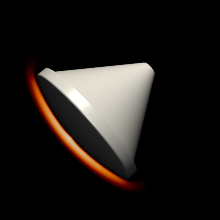Space vehicles entering planetary atmospheres are exposed to high enthalpy gas in strong thermal and chemical non-equilibrium. The high specific enthalpy leads to a significant amount of ionization in the flow, and in addition, the inner degrees of freedom of atoms and molecules become significantly excited. This allows strong gas radiation in the ultra violet and visible wavelength region. On the one hand side, transforming the energy into radiation leads to a cooling effect in the flow, the radiative cooling. On the other hand side, the energy is transported to the spacecraft’s surface, leading to an additional radiative heat flux. Especially for hyperbolic re-entries, this component of the surface heat flux can be substantial.
Due to uncertainties associated with the correct prediction of the heat flux, heat shields are usually equipped with high design margins. Experimental measurements of radiative processes in plasmas are often complicated and very costly. Therefore, numerical simulation of re-entry flows developed as an integral part in the design process of re-entry vehicles with the goal, to reduce design margins and therefore costs.
Typically, CFD methods are used, which are based on the Navier-Stokes equations. Therefore, this type of solvers can only be used in a certain range of gas and plasma regimes. More precisely, the error in CFD results increases in rarefied gases or plasmas and in case of strong thermal and chemical non-equilibrium effects. However, experimental studies have shown that these non-equilibrium effects can be crucial for the correct prediction of radiative heat fluxes and interpretation of spectrometer measurements. To overcome this problem, a gas kinetic description of the plasma is necessary. There, the inner energies, which are the key source for radiative processes, are not necessarily restricted to Boltzmann distributions.
For this purpose, a radiation module has been implemented into PICLas, consisting of a radiation solver and a radiative energy transfer solver. To calculate radiative energy transfer, the change of radiation intensity due to emission and absorption of the surrounding gas in the simulation domain is investigated. Emission coefficients indicate the radiative power emitted per volume, while absorption coefficients describe the radiation absorbed per path length. These coefficients are calculated using a line-by-line code that accounts for both discrete radiative transitions and continuum radiation. To solve the energy transfer through the computational domain, the well established and widely used Monte Carlo method is implemented. It distinguishes by a high accuracy even for geometrically complex problems as well as a high flexibility to spectral and spatial resolution.
Contact




